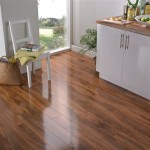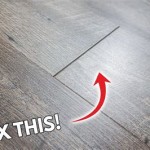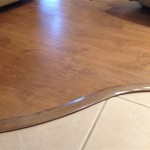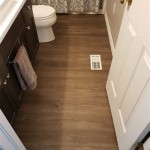Understanding Laminate Floor Thicknesses: A Comprehensive Guide
Laminate flooring has become a popular choice for homeowners and businesses alike due to its durability, affordability, and aesthetic versatility. One of the key factors to consider when selecting laminate flooring is its thickness. The thickness of a laminate floorboard directly impacts its performance, longevity, and suitability for different environments. This guide explores the various laminate flooring thicknesses available, examining their advantages, disadvantages, and ideal applications.
Laminate flooring is a multi-layered synthetic flooring product fused together through a lamination process. The core of the laminate board, often made of high-density fiberboard (HDF) or medium-density fiberboard (MDF), provides the structural stability. A photographic applique layer, mimicking wood, stone, or tile, sits atop the core, providing the visual appeal. Finally, a transparent wear layer protects the decorative layer from scratches, stains, and fading. The overall thickness of the laminate plank comprises these combined layers.
The thickness of laminate flooring is typically measured in millimeters (mm). Common thicknesses range from 6mm to 12mm, with some specialized options extending beyond these parameters. Each thickness offers distinct characteristics and is better suited for specific purposes. Choosing the appropriate thickness is crucial for achieving the desired performance and ensuring the longevity of the flooring installation.
Key Point 1: Common Laminate Flooring Thicknesses and Their Characteristics
Understanding the nuances of each common laminate flooring thickness is essential for making an informed decision. The following sections detail the properties and applications of the most prevalent thicknesses available in the market.
6mm - 7mm Laminate Flooring: This is generally considered the entry-level option for laminate flooring. It is the thinnest and most affordable choice. However, its thin profile also makes it the least durable and most susceptible to damage. 6mm-7mm laminate flooring is suitable for low-traffic areas with minimal wear and tear. It is often used in closets, rarely used guest rooms, or as a temporary flooring solution. Due to its thinness, it may require a perfectly level subfloor to prevent flexing and potential joint separation. Sound absorption is minimal, and it may feel less comfortable underfoot compared to thicker options. Installation is generally easier due to its lightweight nature.
8mm Laminate Flooring: 8mm laminate flooring represents a good balance between affordability and durability. It is a popular choice for residential applications, offering improved resistance to wear and tear compared to thinner options. It can withstand moderate foot traffic and is suitable for living rooms, bedrooms, and hallways in homes with average activity levels. While still requiring a relatively level subfloor, it is more forgiving than 6mm-7mm options. Sound absorption is moderately improved, and it provides a slightly more comfortable feel underfoot. The cost is moderately higher than thinner options, reflecting its improved performance.
10mm Laminate Flooring: 10mm laminate flooring offers enhanced durability and stability. It is a robust option suitable for high-traffic areas in residential settings, such as kitchens, entryways, and playrooms. It can also be used in light commercial applications with moderate foot traffic. The thicker profile provides better resistance to impacts, scratches, and wear. It is more effective at concealing minor imperfections in the subfloor and offers improved sound absorption compared to thinner options. The increased thickness contributes to a more solid and comfortable feel underfoot, simulating the feel of real hardwood. The cost is higher than 8mm options, but the added durability and performance justify the investment in demanding environments.
12mm Laminate Flooring: 12mm laminate flooring represents the premium end of the spectrum. It is the thickest and most durable option, designed to withstand heavy foot traffic and significant wear and tear. It is suitable for high-traffic commercial environments, such as retail stores, offices, and restaurants. It offers exceptional resistance to impacts, scratches, and wear, ensuring long-lasting performance. The added thickness provides superior sound absorption and effectively conceals imperfections in the subfloor. It offers the most comfortable and solid feel underfoot, closely mimicking the feel of hardwood flooring. 12mm laminate flooring is the most expensive option but provides the highest level of performance and longevity, making it a worthwhile investment for demanding applications.
Beyond the standard thicknesses mentioned above, specialized laminate flooring may be available in thicknesses exceeding 12mm. These options are typically designed for specific applications requiring exceptional durability, such as industrial or high-impact environments. These specialty laminates often feature enhanced wear layers and specialized core materials to withstand extreme conditions.
Key Point 2: Factors Influencing the Choice of Laminate Flooring Thickness
Selecting the appropriate laminate flooring thickness involves considering several factors beyond just cost. These factors directly impact the performance, longevity, and suitability of the flooring installation. Careful consideration of these factors ensures that the chosen thickness meets the specific needs of the environment.
Foot Traffic: The level of foot traffic is a crucial determinant in selecting the appropriate laminate flooring thickness. High-traffic areas, such as entryways, hallways, and kitchens, require thicker laminate flooring (10mm-12mm) to withstand the constant wear and tear. Low-traffic areas, such as bedrooms and closets, may be suitable for thinner options (6mm-8mm). Choosing a thickness appropriate for the expected traffic volume will significantly extend the lifespan of the flooring.
Subfloor Condition: The condition of the subfloor also plays a significant role in determining the appropriate laminate flooring thickness. Uneven or imperfect subfloors require thicker laminate flooring (10mm-12mm) to provide stability and prevent flexing. Thicker laminate flooring is better at concealing minor imperfections and preventing joint separation. If the subfloor is significantly uneven, it may need to be leveled before installation, regardless of the chosen laminate thickness.
Budget: Budget constraints often influence the choice of laminate flooring thickness. Thinner options (6mm-8mm) are generally more affordable than thicker options (10mm-12mm). However, it is important to consider the long-term cost of replacing thinner flooring that may wear out more quickly. Investing in thicker flooring can potentially save money in the long run by reducing the need for frequent replacements.
Sound Absorption: The desired level of sound absorption is another factor to consider. Thicker laminate flooring (10mm-12mm) provides better sound absorption than thinner options (6mm-8mm). This is particularly important in multi-story homes or apartments where noise transmission can be a concern. Underlayment can further enhance sound absorption, regardless of the laminate flooring thickness.
Comfort Underfoot: The desired level of comfort underfoot is also a consideration. Thicker laminate flooring (10mm-12mm) provides a more solid and comfortable feel underfoot compared to thinner options (6mm-8mm). The added thickness provides more cushioning and reduces the impact of walking. Underlayment can also contribute to increased comfort underfoot.
Room Usage: The intended use of the room should be considered when selecting laminate flooring thickness. Rooms with high moisture levels, such as bathrooms and laundry rooms, may require specialized water-resistant or waterproof laminate flooring, which may be available in varying thicknesses. Rooms with heavy furniture or appliances may benefit from thicker laminate flooring to prevent dents and scratches.
Key Point 3: Installation Considerations and Underlayment
Regardless of the chosen laminate flooring thickness, proper installation is crucial for achieving optimal performance and longevity. The installation process involves several steps, including subfloor preparation, underlayment installation, and plank placement. The specific installation instructions may vary depending on the manufacturer and the type of locking system used.
Subfloor Preparation: Proper subfloor preparation is essential for a successful laminate flooring installation. The subfloor should be clean, dry, level, and free of debris. Any imperfections or irregularities should be addressed before installation. This may involve filling cracks, sanding high spots, or applying a leveling compound. A properly prepared subfloor ensures that the laminate flooring is stable and prevents flexing or joint separation.
Underlayment Installation: Underlayment is a thin layer of material installed between the subfloor and the laminate flooring. It provides several benefits, including sound absorption, moisture protection, and added comfort underfoot. The type of underlayment should be chosen based on the specific needs of the environment and the recommendations of the laminate flooring manufacturer. Some laminate flooring products come with pre-attached underlayment, eliminating the need for a separate installation step.
Plank Placement: Laminate flooring planks are typically installed using a click-lock system, which allows the planks to be easily snapped together without the need for glue or nails. The installation process typically begins in one corner of the room and progresses row by row. It is important to maintain consistent spacing between the planks and the walls to allow for expansion and contraction. Expansion gaps are typically covered with baseboards or trim.
Acclimation: Laminate flooring should be acclimated to the room temperature and humidity for at least 48 hours before installation. This allows the planks to adjust to the environment and prevents expansion or contraction after installation. Acclimation is particularly important in areas with significant temperature or humidity fluctuations.
Professional Installation: While laminate flooring installation is often considered a DIY project, professional installation is recommended for complex installations or when dealing with challenging subfloor conditions. Professional installers have the expertise and equipment to ensure a proper and long-lasting installation.
In summary, understanding laminate floor thicknesses is paramount to selecting the appropriate flooring for a specific environment. By considering factors such as foot traffic, subfloor condition, budget, and desired level of sound absorption and comfort, informed decisions can be made. Proper installation, including subfloor preparation and underlayment selection, further contributes to the overall performance and longevity of the laminate flooring.

The Ultimate Guide To Laminate Flooring Thickness Surya

Laminate Flooring Thickness Guide Blog Floorsave

8mm Laminate Flooring Difference Between Thickness
Laminate Flooring Thickness Guide All You Need To Know Learning Centerlearning Center

Laminate Flooring Thickness Guide For Specific Room Teka

12mm Laminate Flooring What You Need To Know

What Thickness To Choose When I Buy Vinyl Flooring

Laminate Flooring Thickness Guide Blog Floorsave

Laminate Thickness Explained Flooring Project 5 Carpetright

Optimal Thickness For Laminate Flooring Karma
Related Posts








